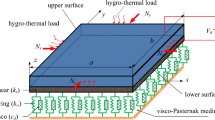Abstract
It is shown that the conventional theory of thermoelasticity is insufficient to explain the behavior of pulsed laser ultrasonic signals from materials with defects. A theoretical model of thermoelasticity is proposed that takes into account the thermal excitation of defect states by laser radiation with their subsequent recovery to the initial state with a certain relaxation time. The linear model of thermoelasticity in terms of slow dynamics is developed. The difference in the behavior of ultrasonic signals from dielectrics and metals under pulsed laser excitation is analyzed and explained. It is shown that in the linear approximation of the thermoelastic model, slow dynamic effects can be taken into account by introducing an effective thermal coefficient.




Similar content being viewed by others
References
Molchanov, I.S., Chin, S.N., Zuyev, S.: Design of inhomogeneous materials with given structural properties. Phys. Rev. A 62, 4544–4552 (2000)
Savage, E.N.: New complex alloys push the limits of materials. ACS Cent. Sci. 7, 1463–1466 (2021)
Vakhnenko, O.O., Vakhnenko, V.O., Shankland, T.J.: Softratchet modeling of end-point memory in the nonlinear resonant response of sedimentary rocks. Phys. Rev. B 71, 174103 (2005)
Guyer, R.A., Johnson, P.A.: Nonlinear mesoscopic elasticity: evidence for a new class of materials. Phys. Today 52, 30 (1999)
Remillieux, M.C., Guyer, R.A., Payan, C., Ulrich, T.J.: Decoupling nonclassical nonlinear behavior of elastic wave types. Phys. Rev. Lett. 116, 115501 (2016)
Lebedev, A.V., Ostrovsky, L.A.: A unified model of hysteresis and long-time relaxation in heterogeneous materials. Acoust. Phys. 60, 555 (2014)
Kober, J., Kruisova, A., Scalerandi, M.: Elastic slow dynamics in polycrystalline alloys. Appl. Sci. 11, 8631 (2021)
Korobov, A.I., Odina, N.I., Mekhedov, D.M.: Effect of slow dynamics on elastic properties of materials with residual and shear strains. Acoust. Phys. 59, 387 (2013)
Glazov, A.L., Muratikov, K.L.: The influence of mechanical stresses in a D16 aluminum-alloy plate on the generation of acoustic waves under laser Irradiation. Tech. Phys. Lett. 45(9), 902–905 (2019)
Glazov, A.L., Muratikov, K.L.: Acoustic oscillations of aluminum membranes laser-excited by a thermoelastic mechanism. Tech. Phys. Lett. 46(5), 477–479 (2020)
Glazov, A.L., Muratikov, K.L.: The influence of mechanical stresses on the characteristics of laser-ultrasonic signals in the vicinity of a hole in silicon nitride ceramics. Tech. Phys. Lett. 47(6), 624–627 (2021)
Glazov, A.L., Muratikov, K.L.: Laser ultrasound imaging of mechanical stresses near holes and indented areas: experimental results and theoretical model. J. Appl. Phys. 131, 245104 (2022)
Glazov, A.L., Muratikov, K.L.: Relaxation effects in thermoelastically generated ultrasound in stressed dielectric and conductive materials. Phys. Rev. B 105, 214104 (2022)
Bentahar, M., Bentahar, H., Aqra, El., El Guerjouma, R., Griffa, M., Scalerandi, M.: Hysteretic elasticity in damaged concrete: Quantitative analysis of slow and fast dynamics. Phys. Rev. B 73, 014116 (2006)
Guyer, R.A., Johnson, P.A.: Nonlinear Mesoscopic Elasticity. Wiley-VCH, Weinheim (2009)
Lott, M., Remillieux, M.C., Garnier, V., Le Bas, P.-Y., Ulrich, T.J., Payan, C.: Nonlinear elasticity in rocks: a comprehensive three-dimensional description. Phys. Rev. Mater. 1, 023603 (2017)
Mirzoev, FKh., Panchenko, V., Ya, V., Shelepin, L.A.: Laser control of processes in solids. J. Phys. Usp. 39, 1 (1996)
Kosevich, A.M.: Physical Mechanics of Real Crystals. Naukova Dumka, Kiev (1981). (in Russian)
Novikova, S.I.: Thermal Expansion of Solids. Izdatel, Nauka, Moscow (1974). ((in Russian))
Sudenkov, Yu.V., Zimin, B.A.: Effect of “the thermal piston” in dynamic thermoelastic problem. Int. J. Heat Mass Transf. 85, 781–786 (2015)
Kovalenko, A.D.: Thermoelasticity Basic theory and applications. Wolters-Noordhoff, Groningen (1970)
Nowacki, W.: Dynamic Problems of Thermoelasticity. Springer, Berlin (1975)
Slepyan, L.I.: Analysis of Non-steady-state Strain by Means of Series Defined in a Variable Interval. Izv. Ac. Sci.USSR, Mekhanika (4), 62–69 (1965) (in Russian)
Indeitsev, D.A., Semenov, B.N., Vavilov, D.S.: On the method of expansion on a variable interval for non-stationary problems in continuum mechanics. Acta Mech. 232(5), 1961–1969 (2021)
Wolverton, C.: Solute-vacancy binding in aluminum. Acta Mater. 55, 5867 (2007)
Clouet, E.: The vacancy-edge dislocation interaction in fcc metals: a comparison between atomic simulations and elasticity theory. Acta Mater. 54, 3543 (2006)
Young, G.A., Jr., Scully, J.R.: The diffusion and trapping of hydrogen in high purity aluminum. Acta Mater. 46, 6337 (1998)
Glazov, A.L., Muratikov, K.L.: Generalized thermoelastic effect in real metals and its application for describing photoacoustic experiments with Al membranes. J. Appl. Phys. 128, 095106 (2020)
Funding
No funding was received for conducting this study.
Author information
Authors and Affiliations
Corresponding author
Ethics declarations
Conflict of interest
The authors have no relevant financial or non-financial interests to disclose.
Additional information
Publisher's Note
Springer Nature remains neutral with regard to jurisdictional claims in published maps and institutional affiliations.
Deceased: Dmitry A. Indeitsev.
Rights and permissions
Springer Nature or its licensor (e.g. a society or other partner) holds exclusive rights to this article under a publishing agreement with the author(s) or other rightsholder(s); author self-archiving of the accepted manuscript version of this article is solely governed by the terms of such publishing agreement and applicable law.
About this article
Cite this article
Morozov, N.F., Indeitsev, D.A., Muratikov, K.L. et al. On the thermoelastic model of real materials with relaxation dynamics of defects. Acta Mech (2024). https://doi.org/10.1007/s00707-024-03924-z
Received:
Accepted:
Published:
DOI: https://doi.org/10.1007/s00707-024-03924-z




